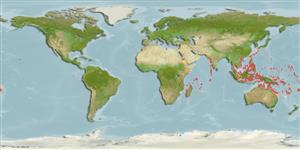>
Gobiiformes (Gobies) >
Gobiidae (Gobies) > Gobiinae
Etymology: Phyllogobius: Greek, phyhllon = leaf + Latin, gobius = gudgeon (Ref. 45335).
More on author: Smith.
Environment: milieu / climate zone / depth range / distribution range
Écologie
marin récifal; profondeur 2 - 18 m (Ref. 90102). Tropical
Western Indian Ocean: Mozambique. Western Central Pacific: Indonesia, Philippines, Solomon Islands, and the Great Barrier Reef.
Taille / Poids / Âge
Maturity: Lm ? range ? - ? cm
Max length : 5.0 cm SL mâle / non sexé; (Ref. 48637)
Description synthétique
Clés d'identification | Morphologie | Morphométrie
Épines dorsales (Total) : 7; Rayons mous dorsaux (Total) : 7 - 8; Épines anales: 1; Rayons mous anaux: 8. Translucent, very finely dotted with red or black; two indistinct longitudinal rows of reddish dashes on back and one along lateral line; red line from upper lip to eye; a U-shaped reddish mark on each side of occiput behind eye (Ref. 27362). Caudal fin rounded (Ref. 27362); characterized further by having an extremely flattened head; unrestricted gill opening; unbranched 6-9 lowermost pectoral rays and thickened distally; longitudinal scale series 28-37; predorsal scales 10-13; depth of body at anus 5.1-9.4 in SL (Ref. 90102).
Inhabits coral reefs (Ref. 42915). Commensal on foliaceous flattened sponges (Phyllospongia) (Ref. 27362, 48637).
Life cycle and mating behavior
Maturité | Reproduction | Frai | Œufs | Fécondité | Larves
Randall, J.E., G.R. Allen and R.C. Steene, 1997. Fishes of the Great Barrier Reef and Coral Sea. Second Edition. Revised and expanded edition. Crawford House Publishing Pty Ltd. Bathurst, NSW, Australia. 557 p. (Ref. 27362)
Statut dans la liste rouge de l'IUCN (Ref. 130435: Version 2024-2)
Menace pour l'homme
Harmless
Utilisations par l'homme
Outils
Articles particuliers
Télécharger en XML
Sources Internet
Estimates based on models
Preferred temperature (Ref.
123201): 25.6 - 29.3, mean 28.4 °C (based on 1857 cells).
Phylogenetic diversity index (Ref.
82804): PD
50 = 1.0000 [Uniqueness, from 0.5 = low to 2.0 = high].
Bayesian length-weight: a=0.00724 (0.00339 - 0.01546), b=3.10 (2.92 - 3.28), in cm total length, based on LWR estimates for this (Sub)family-body shape (Ref.
93245).
Niveau trophique (Ref.
69278): 3.2 ±0.3 se; based on size and trophs of closest relatives
Résilience (Ref.
120179): Haut, temps minimum de doublement de population inférieur à 15 mois (Preliminary K or Fecundity.).
Fishing Vulnerability (Ref.
59153): Low vulnerability (10 of 100).
Nutrients (Ref.
124155): Calcium = 231 [100, 502] mg/100g; Iron = 0.995 [0.489, 1.990] mg/100g; Protein = 17.8 [15.8, 19.5] %; Omega3 = 0.0974 [, ] g/100g; Selenium = 22.6 [9.2, 56.1] μg/100g; VitaminA = 149 [37, 557] μg/100g; Zinc = 2.73 [1.69, 4.21] mg/100g (wet weight);
